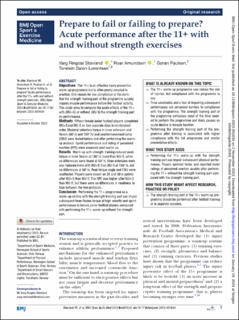| dc.contributor.author | Støvland, Varg Ringdal | |
| dc.contributor.author | Amundsen, Roar | |
| dc.contributor.author | Paulsen, Gøran | |
| dc.contributor.author | Dalen-Lorentsen, Torstein | |
| dc.date.accessioned | 2024-02-09T11:35:19Z | |
| dc.date.available | 2024-02-09T11:35:19Z | |
| dc.date.created | 2023-12-04T12:58:47Z | |
| dc.date.issued | 2023 | |
| dc.identifier.citation | BMJ Open Sport & Exercise Medicine. 2023, 9(4), Artikkel e001634. | en_US |
| dc.identifier.issn | 2055-7647 | |
| dc.identifier.uri | https://hdl.handle.net/11250/3116591 | |
| dc.description | This is an open access article distributed in accordance with the Creative Commons Attribution 4.0 Unported (CC BY 4.0) license, which permits others to copy, redistribute, remix, transform and build upon this work for any purpose, provided the original work is properly cited, a link to the licence is given, and indication of whether changes were made. | en_US |
| dc.description.abstract | Objectives: The 11+ is an effective injury prevention warm-up programme but is often poorly adopted in practice. One reason for low compliance is the claim that the strength training part of the programme acutely impairs muscle performance before the football activity. This study aims to compare the acute effects of the 11+ with (WU+S) or without (WU-S) the strength training part on performance.
Methods: Fifteen female junior football players completed WU+S and WU-S on two separate days in randomised order. Maximal voluntary torque in knee extension and flexion (60°/s and 180°/s) and countermovement jump (CMJ) were tested before and after performing the warm-up protocol. Sprint performance and rating of perceived exertion (RPE) were assessed post-warm-up.
Results: Warm-up with strength training reduced peak torque in knee flexion at 180°/s more than WU-S, while no differences were found at 60°/s. Knee extension work was reduced more with WU+S than WU-S at 180°/s, but no differences at 60°/s. Peak torque angle and CMJ were unaffected. Players were slower on 20 and 30 m sprints after WU+S than WU-S. The RPE was higher after WU+S than WU-S, but there were no differences in readiness to train between the two protocols.
Conclusion: Performing the 11+ programme as a warm-up routine with the strength training part can impair subsequent knee flexion torque at high velocity and sprint performance in female junior football players compared with performing the 11+ warm-up without the strength part. | en_US |
| dc.language.iso | eng | en_US |
| dc.subject | 11+ | en_US |
| dc.subject | FIFA 11+ | en_US |
| dc.subject | health | en_US |
| dc.subject | periodisation | en_US |
| dc.subject | planning | en_US |
| dc.subject | preparation | en_US |
| dc.subject | resistance exercise | en_US |
| dc.subject | session | en_US |
| dc.subject | soccer | en_US |
| dc.subject | warm up | en_US |
| dc.title | Prepare to fail or failing to prepare?: Acute performance after the 11+ with and without strength exercises | en_US |
| dc.type | Peer reviewed | en_US |
| dc.type | Journal article | en_US |
| dc.description.version | publishedVersion | en_US |
| dc.rights.holder | © Author(s) (or their employer(s)) 2023 | en_US |
| dc.source.pagenumber | 7 | en_US |
| dc.source.volume | 9 | en_US |
| dc.source.journal | BMJ Open Sport & Exercise Medicine | en_US |
| dc.source.issue | 4 | en_US |
| dc.identifier.doi | 10.1136/bmjsem-2023-001634 | |
| dc.identifier.cristin | 2208439 | |
| dc.description.localcode | Institutt for idrettsmedisinske fag / Department of Sports Medicine | en_US |
| dc.source.articlenumber | e001634 | en_US |
| cristin.ispublished | true | |
| cristin.fulltext | original | |
| cristin.qualitycode | 1 | |
